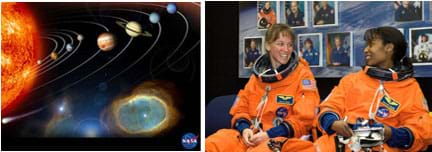
Summary
An introduction to our solar system—the planets, our Sun and Moon. To begin, students learn about the history and engineering of space travel. They make simple rockets to acquire a basic understanding of Newton's third law of motion. They explore energy transfer concepts and use renewable solar energy for cooking. They see how engineers design tools, equipment and spacecraft to go where it is too far and too dangerous for humans. They explore the Earth's water cycle, and gravity as applied to orbiting bodies. They learn the steps of the design process as they create their own models of planetary rovers made of edible parts. Students conduct experiments to examine soil for signs of life, and explore orbit transfers. While studying about the International Space Station, they investigate the realities of living in space. Activities explore low gravity on human muscles, eating in microgravity, and satellite tracking. Finally, students learn about the context of our solar system—the universe—as they learn about the Hubble Space Telescope, celestial navigation and spectroscopy.Engineering Connection
Engineers apply their understanding of science (laws of motion, energy transfer, solar energy, water cycle, moon phases, gravity, spectroscopy, materials science, human body, chemical analysis) and math (geometry, data collection, velocity calculations, navigation, satellite tracking, fuel efficiency, calculating spacecraft maneuvers) to creating the spacecraft vehicles, equipment, tools and methods to explore our solar system.
If students are interested in astronauts, space walks, rockets, rockets and images of the distant universe, they might want to pursue their dreams and become engineers. More than just aerospace engineers work in the space industry. Biomedical, chemical, mechanical, electrical and computer (and other) engineers work together to make spacesuits, design life support systems, create new materials for spacecraft, and design control systems, cameras, communications, etc. The space industry provides endless opportunities—requiring a wide range and depth of study and expertise. Teams of engineers follow the steps of the engineering design process to create telescopes, deep space antennas, spacecraft, planetary rovers and even how to eat in microgravity, as well as conduct research and cultivate international cooperation.
Educational Standards
Each TeachEngineering lesson or activity is correlated to one or more K-12 science,
technology, engineering or math (STEM) educational standards.
All 100,000+ K-12 STEM standards covered in TeachEngineering are collected, maintained and packaged by the Achievement Standards Network (ASN),
a project of D2L (www.achievementstandards.org).
In the ASN, standards are hierarchically structured: first by source; e.g., by state; within source by type; e.g., science or mathematics;
within type by subtype, then by grade, etc.
Each TeachEngineering lesson or activity is correlated to one or more K-12 science, technology, engineering or math (STEM) educational standards.
All 100,000+ K-12 STEM standards covered in TeachEngineering are collected, maintained and packaged by the Achievement Standards Network (ASN), a project of D2L (www.achievementstandards.org).
In the ASN, standards are hierarchically structured: first by source; e.g., by state; within source by type; e.g., science or mathematics; within type by subtype, then by grade, etc.
See individual lessons and activities for standards alignment.
Subscribe
Get the inside scoop on all things TeachEngineering such as new site features, curriculum updates, video releases, and more by signing up for our newsletter!Unit Schedule
The following schedule provides a suggested order of the lessons and activities. However, you may choose to only teach some of the activities – as your time and priorities permit.
- Destination Outer Space lesson
- Rocket Power activity
- Blazing Gas lesson
- Our Sun and Heat Transfer Basics: Heat It Up! activity
- Mercury and Venus lesson
- Spacecraft Design: Beat the Heat activity
- Our Big Blue Marble lesson
- The Great Gravity Escape activity
- What Happened to the Water? Designing Ways to Get and Clean Water activity
- Moon Walk lesson
- Lunar Lollipops activity
- Mars and Jupiter lesson
- A Roundabout Way to Mars activity
- Are We Alone? activity
- Edible Rovers activity
- The Outer Planets lesson
- Slingshot to the Outer Planets activity
- Life in Space: The International Space Station lesson
- Lunch in Outer Space! activity
- Muscles, Muscles Everywhere activity
- Beyond the Milky Way lesson
- Building a Fancy Spectrograph activity
- The North (Wall) Star activity
Worksheets and Attachments
Visit [www.teachengineering.org/curricularunits/view/cub_solar_curricularunit] to print or download.More Curriculum Like This

Students learn how engineers navigate satellites in orbit around the Earth and on their way to other planets in the solar system. In accompanying activities, they explore how ground-based tracking and onboard measurements are performed.

Students are introduced to the International Space Station (ISS) with information about its structure, operation and key experiments.

Students acquire a basic understanding of the science and engineering of space travel as well as a brief history of space exploration. They learn about the scientists and engineers who made space travel possible and briefly examine some famous space missions.
Copyright
© 2006 by Regents of the University of ColoradoContributors
See individual lessons and activities.Supporting Program
Integrated Teaching and Learning Program, College of Engineering and Applied Science, University of Colorado BoulderAcknowledgements
This digital library content was developed under National Science Foundation GK-12 grant no. 0338326. However, these contents do not necessarily represent the policies of the NSF, and you should not assume endorsement by the federal government.
Last modified: March 29, 2022






User Comments & Tips